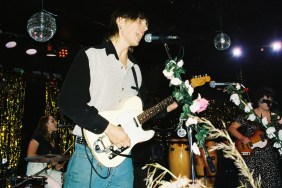UK indie pop outfit Low Island put a lot of heart into their second album Life in Miniature. For vocalist and songwriter Carlos Posada, the album represents “a journey through three years of accelerated change that felt like a lifetime.”
Posada and his bandmates, Felix Higginbottom, Jacob Lively and Jamie Jay, recorded the album with engineer Tom Archer in various UK locations as well as the French commune, Marcenay.
Throughout the writing process, Posada was inspired by the writing of Miriam Dobson, Maria Stepanova and his late grandfather’s poetry, along with songwriters Joni Mitchell and Future Islands. Here, Posada tells the story of Life in Miniature through the lens of his influences.
Low Island – ‘Can’t Forget’
Carlos Posada: The early recording sessions for our second album, Life In Miniature, started in a village in rural France. We arrived with a fairly large collection of demos but, unlike when we started recording our first album properly, these demos were much more sketch-like – lyrics, melodies, instrumental parts, sections or even entire songs were missing and needed to be filled in.
With engineer Tom Archer, we split up into teams, creating three different makeshift studios in the old farmhouse we were staying in: one studio for tracking live instruments, one for synths and post-production, and another as a little writing room with a piano, where I would spend a good chunk of most days finishing songs, writing sections we felt were missing, and generally trying to make a sense of the album as a whole.
A lot of that time was spent reading. One of the things I read out there was an article called ‘Kid Gloves’ by Miriam Dobson in the London Review of Books. Dobson was reviewing a book by Maria Stepanova called In Memory of Memory, an account of Russian cultural life over the past century told through the lens of Stepanova’s family history, building her story out of the paraphernalia they had left behind: “…piled-up photographs and postcards, thermal vests and leggings, books and newspapers, ivory brooches and embroidered shirts, considering this odd accumulation of objects which only really had meaning ‘within the frame of a continuing life.'”
That idea of sifting through memories, trying to make sense of them but also simply finding something to do with them, to bring them all together to create something greater than the sum of their parts, became the guiding principle for the lyrics in Life In Miniature.
Low Island – ‘Wasn’t For Nothing’
In this album’s case, the period of time in question did not span a century but rather the first three years of the pandemic. It was a time filled with emotional extremes and big life changes. I left home, fell in love, and lost people dear to me who may have survived longer had circumstances been different.
There were two songs in particular that helped me in making sense of how to write about seismic change: Future Islands’ ‘Seasons (Waiting On You)’ and Joni Mitchell’s ‘Both Sides Now.’ It was important to me that the album try to find the beauty in looking at the past “from both sides now,” and also to find some kind of acceptance in life’s contingencies; that “when people change, they gain a piece, but they lose one too,” as Samuel T. Herring so beautifully sings in Future Islands’ ‘Seasons.’
“Life In Miniature became a sort of archiving process, an attempt to capture the light and shade of those years.”
The source material for the lyrics ranged from small memories that only existed in my head to photographs, family heirlooms and letters. An image in my mind’s eye of my dad waving me away in my car as I left home for the first time provided the foundations for the song ‘Can’t Forget’. A closing line in a poem my late-grandfather wrote for me – “Life’s ups and downs, my love is true” – became part of the chorus in ‘Forever Is Too Long’. A sample of my great-grandmother – a regional actor in the 30s – performing a song called ‘I Love You More and More’ framed the track ‘Robin.’ And in the same way that memory doesn’t follow any kind of chronology, the idea was that these random, disconnected recollections would flit in and out of the record, coming together to form the whole.
Jamie’s production has always been amazing at channeling these ideas. He’d come up with all of these whirring soundscapes, some even constructed out of other songs on the record, as is the case with the closing track ‘Life In Miniature.’
There were other details that tied in with the stitching together of memories. For instance, at the beginning of ‘Goodbye Bluefin,’ you can hear one of us counting the band in to the first rehearsal of the song in our Oxford studio; at around the 40 second mark in ‘Come A Long Way,’ the sound of the fridge from the old French house we recorded in makes an appearance; and at the end of ‘Into The Blue,’ we included a voice note of a first sketch of the song from my little studio in North London, alongside a recording of us cheering the moment we finally worked out the bridge.
It all added to the idea of the album being a kind of time capsule, a collection of different moments, some significant, some trivial, some blissfully happy, some desperately sad, all side by side. And as time adds more distance between us and these memories, I hope that we can look back on Life In Miniature and at least say – to paraphrase the author Penelope Lively in her book Dancing Fish and Other Ammonites – this is where we were, and this is what we did.
Further Reading
The Stories Behind the Covers on Bruce Springsteen’s ‘Only the Strong Survive’












